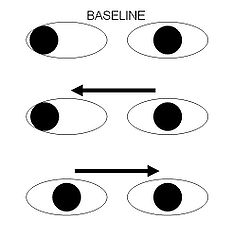One and a half syndrome

The one and a half syndrome is a rare cause of ophthalmoparesis characterized by "a conjugate horizontal gaze palsy in one direction and an internuclear ophthalmoplegia in the other".[1] The most common manifestation of this unusual syndrome is limitation of horizontal eye movement to abduction of one eye with no horizontal movement of the other eye. Convergence is classically spared as Cranial Nerve III (oculomotor nerve) and its nucleus is spared bilaterally.
Anatomy
The syndrome usually results from a single unilateral lesion of the paramedian pontine reticular formation which also involves the ipsilateral medial longitudinal fasciculus. An alternative anatomical cause is a lesion of the abducens nucleus on one side, with interruption of the ipsilateral medial longitudinal fasciculus after it has crossed the midline from its site of origin in the contralateral abducens nucleus (resulting in a failure of adduction of the ipsilateral eye).
Causes
Causes of the one and a half syndrome include pontine hemorrhage, ischemia, tumors, infective mass lesions such as tuberculomas, and demyelinating conditions like multiple sclerosis.
Treatment
There have been cases of improvement in extra-ocular movement with botulinum toxin injection.[2]
References
- ↑ Wall M, Wray S (1983). "The one-and-a-half syndrome--a unilateral disorder of the pontine tegmentum: a study of 20 cases and review of the literature". Neurology. 33 (8): 971–80. PMID 6683820.
- ↑ Kipioti A, Taylor R (2003). "Botulinum toxin treatment of "one and a half syndrome"". Br J Ophthalmol. 87 (7): 918–9. PMID 12812899.